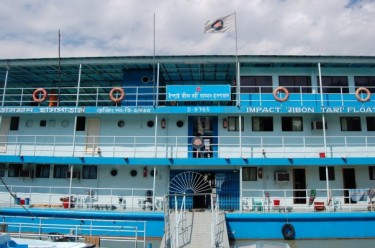Bangladesh is a country of 160 million people and most of them live in villages that are close to riverbanks. The land is criss-crossed with many rivers of different length and width, most eventually pouring into the Bay of Bengal in the country’s south. They come to almost 700, including the branching streams- and make up a 15,000 mile long water network, one of the largest in the world.
On this large network of waterways, a river barge called the Jibon Tari has been sailing to the most remote regions of the country, bringing doctors, nurses and medicines closer to people who, until then, did not have ready access to such medical facilities.
The name Jibon Tari, taken from a poem by the Bengali writer Rabindranath Tagore, means the Boat of Life. It is a floating hospital, the first of its kind in Bangladesh. It started its journey on the 10 April, 1999, from the riverbank of Mawa in Munshiganj district. The inspired vision was to build a hospital which could be taken to the people in need where the accessibility of medical help is particularly poor.

Jibon Tari is anchoring near remote villages, bringing doctors, nurses and medicines. Image courtesy Facebook page of Impact Foundation Bangladesh.
The boat is funded by Impact Foundation Bangladesh, which is a branch of a London-based aid organisation specialized in helping to cure disability in the developing world.
The Jibon Tari is a specially built three-deck engineless barge pulled by tugs from one place to another. It is equipped with modern hospital facilities and equipment to provide excellent and affordable medical and surgical treatment to tens of thousands of under-served people. It is 40 meter x 10 meter in size, with an air-conditioned large surgical theatre with three operating tables, a 3 bed post-operative room, a 12 bed in-patient ward, an x-ray machine and a pathology laboratory.
It also includes outpatient clinics and the top deck contains live-in accommodations and a state of the art training facility. It has accommodation facilities for on-board doctors, nurses, visiting volunteer surgeons and other support staff. The welcome initiative has been featured on CNN. Here is a video of the CNN coverage.
HelpThemSmile blog shares the story of Mita, a girl from a rural poor family with a cleft lip who was cured at Jibon Tari:
One day he (Mita's father Fazlul Haque, a poor farmer) came to know from a medicine shop owner that there is a boat hospital somewhere where they are correcting this type of defect in gratis…He got the location of Jibon-Tari, which was located at Chamrarghat of Kisoregonj district. Fazlul haque became upset again because it is so far, almost 500 kilometers from the place where he lived. Determined to try again for his daughter, one morning he started his journey with his daughter for Chamrarghat.
The on duty doctor of Jiban Tari examined Mita and informed her father that she could be cured through surgery…The surgery was performed and stitches were removed after a week. Fazlul Haque was overjoyed when he saw the changed face of his beloved daughter.
Aussi Bangla Smile is a team of nurses, surgeons and anaesthetists from Australia who came to Bangladesh on multiple missions to perform life-changing surgeries on cleft lip and cleft palate patients in Bangladesh. The Aussi Bangla Smile Project members used their annual leaves to find time for theses missions and even paid their own air fares. They also played a vital role in raising funds for the medical equipment and supplies.
Dr. Hasan Sarwar tells the story of how the Aussi Bangla team changed a little child Marium's life by operating on her cleft lip in the Jibon Tari Hospital:
Just after being born with a bilateral cleft lip and palate, baby Marium, perhaps only a day old, was abandoned on a public bus. She was discovered by some passengers, and then the police placed her in an orphanage in Mymensingh, Bangladesh.
A good friend [..] brought Marium to the Aussi Bangla Smile team at the Jibon Tari floating Hospital which was then about two hours travel from the orphanage… At the time of her operation, Marium was nearly five months old. Due to her deformity, she was unable to eat properly. She was anaemic, malnourished, and weighed only 4kg.
The operation was performed by Dr Sarwar. Post-operative recovery was uneventful, and the next morning Marium looked very happy and began smiling which captured everyone’s hearts.
Team Leader Judy Barlow and the rest of the team were so moved that they decided to sponsor Marium up to the age of 10. Ten team members immediately donated AU$360 (27,720 Taka) for one year’s expenditure on milk and other needs.
Since its launch the Jibon Tari has provided primary health care services to a total of 377,416 people. 31,099 patients underwent surgeries including orthopedics, plastic surgery, eye and ear, nose and throat. 70,853 different types of pathological tests were done. X-rays of 16,760 patients were taken. 19,090 patients had Intra Ocular Lenses (IOL) implanted in their eyes during Cataract Surgery. 7,548 patients received physiotherapy treatment, 335,381 people received health information on prevention of disability. 2,376 received training on antenatal care, postnatal care and safe motherhood. 1,849 NGO workers, school teachers and community leaders received training on nutrition and their relationship with disability. (Source)
Andrina Schwartz visited the hospital and shared her reactions in a post titled ‘Hope Floats':
The floating hospital looks like any other three-story building when you see it from a distance. But as you get closer, you realize it’s not connected to land – it’s sitting in the middle of a river surrounded by rice patties. [..]
Jibon Tari will remain in its current location for 3-6 months. During that time, basic ailments will be healed, sight restored, clubbed feet repaired, and smiles will take the place of cleft lips. All of which will bring hope back to the people of rural Bangladesh.








2 comments